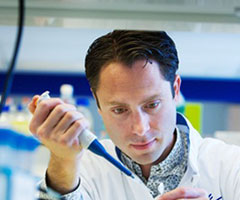Investigating combined drug treatments
Fast facts
-
Official title: The WINDOW consortium for glioblastoma: targeting intra- and inter-patient heterogeneity
- Collaborating researchers: Professor Thomas Wurdinger and Dr Bart Westerman; Professor Colin Watts; and Dr David Bailey
- Where: VU University Medical Centre, Netherlands; The university of Birmingham, UK; and IOTA Pharmaceuticals, UK
- When: October 2017 – September 2022
- Cost: £1.5 million over six years
- Research type: Adult, Glioblastoma (High Grade), Academic, Translational
- Grant round: Quest for Cures
What is it?
The failure of singular chemotherapy treatment options could be overcome by using combination therapies, which includes the use of two or more drugs to treat glioblastomas. Combination therapies would let doctors target multiple aspects of the tumour, allowing for more effective treatment regimens.
So far, choosing drug combinations has been done on the basis of trial and error. The aim of the research led by Dr Westerman is to create a drug database called the Drug Atlas. This database will provide the optimal drug combinations based on a host of factors, including dosage and toxicity. These combinations will be tested on brain tumour samples collected from patients with glioblastomas.
In addition, the combination therapies will be comprised of drugs that are already being used in clinical settings, allowing them to accelerate the findings of this study to clinical trials.
To determine potential drug resistance, the researchers will manipulate the cells to assess if the changes make the cells more susceptible to the drug combinations.
Until now personalised medicine has only looked at differences across patient groups. Our research goes beyond that, focusing on the differences in individual tumours as they develop, letting us detect important characteristics for personalised treatments.
Dr Bart Westerman
Why is it important?
Glioblastomas, the most common and aggressive form of brain cancer, result in poor prognoses for people diagnosed with this tumour. The poor prognoses can be attributed to the composition of the tumour, as glioblastomas are made up of different types of cells. This diverse composition results in the failure of chemotherapeutic and targeted approaches. Despite our improved knowledge regarding the makeup of this tumour type, there remains a lack of effective treatments, making it essential to get new discoveries to the clinic.
Who will it help?
This collaborative research programme aims to create a paradigm shift in the management of glioblastomas. The research will take into account the differences within each tumour and among individuals suffering from a glioblastoma. In doing so, this research hopes to improve the survival of people diagnosed with glioblastoma.
Milestones
Achieved
- The research team partnered with IOTA Pharmaceuticals and together have launched the creation of the Drug Atlas. This drug databank will expedite research into drugs that already show promise in pre-clinical studies of glioblastoma, including 132 drugs approved by the Food and Drug Administration (FDA). You can view the drug databank here: http://www.gbmdrugbank.com/
- Dr Würdinger’s team have created a biobank of tumour samples from individuals that have had surgery. These samples have been fundamental in the subsequent research of new drug treatments for glioblastoma.
- The researchers have used artificial intelligence to develop a model that can predict which drugs are likely to be able to cross the blood brain barrier and target tumours successfully. Using this, they can screen many more drug combinations and focus in on those which show the most potential.
- Using the biobanked samples and the AI model together, the researchers have identified and tested the 43 most promising drug combinations and shortlisted the 15 therapies shown to be effective in lab experiments using glioblastoma cells.
Upcoming
- The researchers are also going to monitor any tumours that resist the anticipated effects of the drugs. They aim to identify what is causing this drug resistance by looking at the genetic make-up of individual cells. By understanding what is driving the drug resistance, they can then attempt to manipulate the drugs to combat this.
- Dr Westerman and his team are continuing to screen as many drug combinations as possible. This is helping to grow the GBM Drug Bank which is guiding the selection of effective drug combinations to try and improve survival in people with glioblastomas.
Research is one way your regular gift can make a difference
Research is the only way we will discover kinder, more effective treatments and, ultimately, stamp out brain tumours – for good! However, brain tumours are complex and research in to them takes a great deal of time and money.
Across the UK, over 100,000 families are facing the overwhelming diagnosis of a brain tumour and it is only through the generosity of people like you can we continue to help them.
But, by setting up a regular gift – as little as £2 per month – you can ensure that families no longer face this destructive disease.
In this section

Professor Thomas Wurdinger
Thomas is a Professor at the cancer center of Amsterdam at the Free University (VU) and director of the neuro-oncology research group, which is an integral part of the Amsterdam brain tumour center.